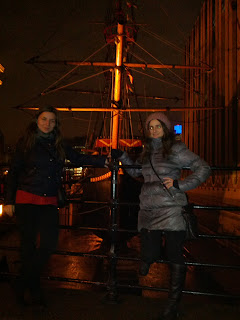I am happy that I had the opportunity to be present at what I think is the second most important European Perl conference: the London Perl Workshop. I'll try to describe the short but intense journey in a way that will convince even more people to be present in the future.
We were 19 members of cluj.pm present at LPW - I think we were the second largest mongers group (after the london mongers, of course) and this wouldn't have been possible without the support from Evozon who paid half of our expenses. We woke up at 4 am (2 am - London time ) and we were all at the airport at 5:30 am. After a flight of about 3 hours (the landing was delayed because the foggy weather in Luton) and another 1 hour trip with the train from Luton, we were finally in London at 9:30 am (London time). We reached Westminster University (the avenue of the London Perl Workshop) around 10:30.
We were 19 members of cluj.pm present at LPW - I think we were the second largest mongers group (after the london mongers, of course) and this wouldn't have been possible without the support from Evozon who paid half of our expenses. We woke up at 4 am (2 am - London time ) and we were all at the airport at 5:30 am. After a flight of about 3 hours (the landing was delayed because the foggy weather in Luton) and another 1 hour trip with the train from Luton, we were finally in London at 9:30 am (London time). We reached Westminster University (the avenue of the London Perl Workshop) around 10:30.
London Perl Workshop - Talks
First talk I attended was Documentation For Fun And Profit - presented by James Aitken (LoonyPandora). It was a nice reminder why we have to write documentation. What I liked most was his point regarding profit: "If one has to choose between two software solutions, he will likely chose the one that is more documented, even if it is not necessarily a better solution".
Next, it was Aaron Crane's Calamitous Context: Stop Breaking My Code!. As he mentioned himself in the presentation, many of the ideas he presented were inspired by Damian's Conway Perl Best Practices. The conclusion I left was that my programming style - returning either an array ref, either using an empty return is good enough (as Aaron pointed out there are cases when returning an array ref adds more complexity to the code that processes that result - but I think that the headaches avoided by using only scalar contexts for function calls is definitely worth that extra complexity ). It was nice to have an addendum to Damian's chapter and definitely worth spending my time watching Aaron.
Matthew Bloch showed us the architecture behind Bytemark's BigV cloud platform. It was a little too much information for me to grasp at that time of the day and I am waiting for the supporting slides to made public to re-read the stuff that I missed.
Yandex.Direct (the equivalent of Google Adsense in Russia, Ukraine, Kazakhstan and Turkey) showed us more of their Perl toolbox by having Elena Bolshakova talking about Looking into the program. It was a nice talk, but I think Elena focused too much on the already existing debugging cpan modules instead of talking more about Devel::YCallTrace - a debugging/profiling/tracing module that seems to fill the gaps and unite in a single place all the nice features that existing packages offer separately.
DuckDuckGo (a newcomer, but important player in the search engine world industry) had Torsten Raudssus (Getty) talking about Moving the needle or what I (should have) learned at DuckDuckGo. This was a business oriented presentation - for software developers. The main idea is that us, developers, should focus on bringing more business value to the product, rather than on the number of features that a project has. I liked the explanations for 2 of duckduckgo's increases in number of users - they were both unrelated to product features:
- one took place when they placed a billboard on the road that goes to Google's headquarter
- the other one (the big one, marked by point J in the graph) took place when Google changed their privacy policy (when they demanded that they'll use their users data however they want)
It followed the lunch break. It was longer than an hour, and the meal was pretty expensive (about 8 pounds for a shaworma with fries) but it was well worth - I took these pictures of myself and some of my colleagues on the famous Oxford Street:
The conference started abruptly after my extended launch break with Matt S Trout (MST) talking about Fast, furious, fatpacked and fun. As always, it was a pleasure watching Matt presenting. I liked most the way he implemented the generic and reusable request dispatchers for the supporting framework behind shadowcat's blog.
It followed the discussion about The state of the Perl jobs market. The conclusions were that there is a high demand for Perl developers on the market (only in that room there were people who needed more than 40 Perl devs right away). Interestingly enough, employers don't need the candidates to know Perl, they have programs to (cross) train them. We also found out that it seems there is also a good side of the fact that Perl is not so popular anymore: there are not so many self taught (many having low programming skills) developers like in the world of PHP and recently Ruby and Python.
This means that employers have smaller chances to hire bad devs. Also, the scarcity of Perl developers makes our payment rates to be higher than Ruby, PHP or Python developers.
From the lightning talks, I found out that the UK's government is an open source contributor, having a public github profile, and working with Perl.
Visiting London.
Taking into consideration that we were supposed to be back in Cluj on Sunday, and the tight schedule, I thought we won't be able to see anything in London. Happily I was mistaken and we got to visit quite much.
As a general point of view, London is impressive - there is no single thing that I could say that had left me bad feelings: the buildings are clean and very well conserved, the streets are very clean (although there are rather few bins), there are virtually no cars parked on the sidewalks and the traffic is light (probably because it was Saturday and because of the tax that drivers have to pay for circulating inside the city).
Prices are high for food (8 pounds for a shaworma) and transportation (4.3 pounds for a subway), but low for clothes (I could find known branded clothes cheaper than in Romania).
Because, we couldn't take part in the post conference social event, AND visit London, I skipped the social event, teamed with Tudor, Adela, Florentina and Diana and took a fast walk through London:
I'd like to say thanks to Mark Keating and all the volunteers involved in organizing this great event and also to Mircea Patachi who had the idea of replacing Evozon's semester Perl department team building with this trip to LPW, and also implementing it.
When we got back home, I had the pleasant surprise to find out that Cluj-Napoca won the competition and will be European Youth Capital in 2015 - congratulations to Democratic Liberal Party and especially Emil Boc for all the efforts you've made to make this possible. I think this is a good sign and hope that Cluj will become the European Capital of Culture in 2021.
When we got back home, I had the pleasant surprise to find out that Cluj-Napoca won the competition and will be European Youth Capital in 2015 - congratulations to Democratic Liberal Party and especially Emil Boc for all the efforts you've made to make this possible. I think this is a good sign and hope that Cluj will become the European Capital of Culture in 2021.





















